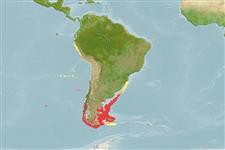>
Perciformes/Notothenioidei (Icefishes) >
Nototheniidae (Cod icefishes) > Nototheniinae
Etymology: Patagonotothen: Composed from Patagonia, the Argentinian province + Greek,noton = back + Greek, adverbial particle, then, that denotes distance or removal (Ref. 45335).
More on author: Richardson.
Environment: milieu / climate zone / depth range / distribution range
Ökologie
seewasser demersal. Temperate
Southeast Pacific and Southwest Atlantic.
Size / Gewicht / Alter
Maturity: Lm ? range ? - ? cm
Max length : 11.0 cm TL Männchen/unbestimmt; (Ref. 37311)
Afterflossenweichstrahlen: 27 - 31. Opercles scaled only on the upper part of the operculum and the upper surface of the head naked; upper lateral line with 33-42 tubular scales; 2-23 scales in the middle lateral line; caudal peduncle much deeper than long; dorsal surface of head without prominent ridges; pectorals as long as or a little longer than pelvic fins; dark brown with some spots and stripes (Ref. 37311).
Life cycle and mating behavior
Geschlechtsreife | Fortpflanzung | Ablaichen | Eier | Fecundity | Larven
Lloris, D. and J. Rucabado, 1991. Ictiofauna del Canal Beagle (Tierra de Fuego), aspectos ecológicos y análisis biogeográfico. Publ. Espec. Inst. Esp. Oceanogr. 8, Madrid, Spain. 182 p. (Ref. 27092)
IUCN Rote Liste Status (Ref. 130435)
Bedrohung für Menschen
Harmless
Nutzung durch Menschen
Mehr Information
NamenSynonymeMetabolismusRäuberÖkotoxikologieFortpflanzungGeschlechtsreifeAblaichenSpawning aggregationFecundityEierEientwicklung
Alter/GrößeWachstumLänge-GewichtLänge-LängeLängenhäufigkeitenMorphometrieMorphologieLarvenLarven Pop.Dyn.RekrutierungDichteBRUVS
ReferenzenAquakulturAquakultur ProfilZuchtlinienGenetikElectrophoresesVererbbarkeitKrankheitenVerarbeitungNutrientsMass conversion
PartnerBilderStamps, Coins Misc.LauteCiguateraGeschwindigkeitSchwimmstilKiemenoberflächeOtolithsGehirngrößeSehfähigkeit
Tools
Zusatzinformationen
Download XML
Internet Quellen
Estimates based on models
Preferred temperature (Ref.
123201): 4.7 - 9.9, mean 6.1 °C (based on 116 cells).
Phylogenetic diversity index (Ref.
82804): PD
50 = 0.5001 [Uniqueness, from 0.5 = low to 2.0 = high].
Bayesian length-weight: a=0.00589 (0.00287 - 0.01207), b=3.23 (3.06 - 3.40), in cm total length, based on LWR estimates for this (Sub)family-body shape (Ref.
93245).
Trophic level (Ref.
69278): 3.5 ±0.5 se; based on size and trophs of closest relatives
Widerstandsfähigkeit (Ref.
120179): mittel, Verdopplung der Population dauert 1,4 - 4,4 Jahre. (Assuming fec < 10,000).
Fishing Vulnerability (Ref.
59153): Low vulnerability (10 of 100).
Nutrients (Ref.
124155): Calcium = 84.1 [52.4, 205.1] mg/100g; Iron = 0.565 [0.333, 1.018] mg/100g; Protein = 17.9 [16.5, 19.3] %; Omega3 = 0.804 [0.433, 1.497] g/100g; Selenium = 10.8 [5.0, 23.0] μg/100g; VitaminA = 40.2 [11.2, 139.4] μg/100g; Zinc = 0.787 [0.541, 1.144] mg/100g (wet weight);
